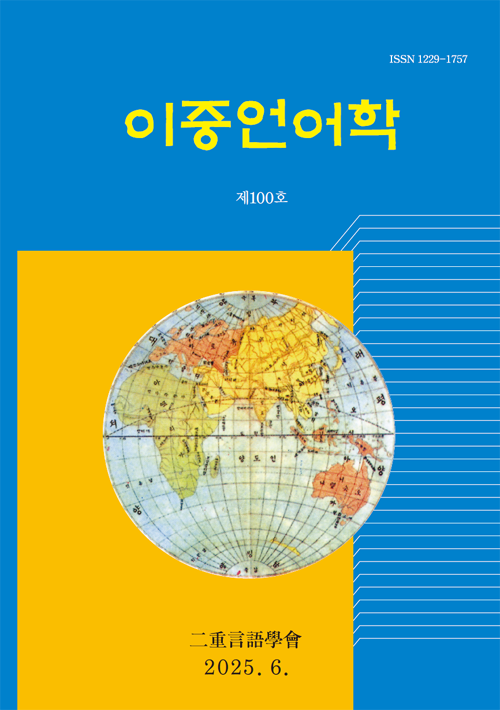- 영문명
- Comparison of conflict resolution methods and speech patterns between Chinese advanced Korean learners and Korean native speakers.
- 발행기관
- 이중언어학회
- 저자명
- 양우동(Yutong Yang) 레이(Niu Lei) 왕아선(Yaxuan Wang) 권순희(Soon Hee Kwon)
- 간행물 정보
- 『이중언어학』제100호, 241~272쪽, 전체 32쪽
- 주제분류
- 인문학 > 언어학
- 파일형태
- 발행일자
- 2025.06.30
6,640원
구매일시로부터 72시간 이내에 다운로드 가능합니다.
이 학술논문 정보는 (주)교보문고와 각 발행기관 사이에 저작물 이용 계약이 체결된 것으로, 교보문고를 통해 제공되고 있습니다.

국문 초록
본 연구는 중국인 고급 한국어 학습자와 한국어 모어 화자가 갈등 대화 해결 방식과 발화 양상의 차이점을 비교·분석하여 갈등 상황에서 효과적인 발화를 구사할 수 있는 한국어교육 시사점을 제시하는 것을 목표로 한다.
중국인 고급 한국어 학습자와 한국인 모어 화자 각각 20명을 대상으로 줌을 이용해 구조화된 면담을 진행하였으며, Thomas(2008)에서 제시된 갈등 해결 방식 분석 도구에 따라 면담 내용을 ‘경쟁’, ‘협력’, ‘절충’, ‘회피’, ‘양보’ 다섯 가지로 분류하여 셈하였고 질적 분석을 실시하였다.
중국어 고급 한국어 학습자와 한국어 모어 화자가 갈등 상황에서 모두 ‘경쟁’을 가장 많이 사용한다는 것이 확인되었다. 중국인 학습자의 경우는 ‘경쟁(52.2%) > 절충(15.5%) > 회피(15.2%) > 협력(12.1%) > 양보(5.9%)’ 순으로 나타났으며, 한국인의 경우는 ‘경쟁(30.1%) > 협력(24.0%) > 회피(22.2%) > 절충(21.5%) > 양보(2.2%)’ 순으로 나타났다. 언어, 문화, 관습 등 요인으로 인해 중국인과 한국인이 한국어 갈등 상황에서 사용된 발화 방식에 차이가 있다고 밝혔으며, 갈등 상황에서 상대방의 욕구를 고려하면서 상대방을 이해해 주는 협력적인 대화를 가르칠 필요성을 강조하였다.
관계 지향적 의사소통을 중시하는 한국어교육에서 바람직한 갈등 해결 발화 방식을 가르치는 데 시사점을 제시하였다.
영문 초록
This study aims to compare and analyze the differences in conflict resolution methods and speech patterns between Chinese advanced Korean learners and native Korean speakers, and to suggest implications for Korean language education that can enable effective speech in conflict situations. Structured interviews were conducted via Zoom with 20 Chinese advanced Korean learners and 20 Korean native speakers. The interview content was classified into five categories of ‘competing’ ‘collaborating,’ ‘compromising,’ ‘avoiding,’ and ‘accommodating’ according to the conflict resolution analysis tool suggested by Thomas (2008), and a qualitative analysis was conducted. It was confirmed that both Chinese advanced Korean learners and native Korean speakers used ‘competing’ the most in conflict situations. For Chinese learners, the order was ‘competing (53.3%) > avoiding (15.3%) > compromising (14.4%) > collaborating (12.3%) > accommodating (4.8%)’, while for Koreans, the order was ‘competing (30.1%) > collaborating (24.0%) > avoiding (22.2%) > compromising (21.5%) > accommodating (2.2%)’. They revealed that there are differences in the way Chinese and Koreans speak in Korean-language conflict situations due to factors such as language, culture, and customs, and they emphasized the need to teach cooperative conversation that considers the listener’s needs and understands the listener in conflict situations. It suggested implications for teaching desirable conflict resolution speech styles in Korean language education that emphasizes relationship-oriented communication.
목차
1. 서론
2. 갈등 상황 및 해결 방식에 관한 이론
3. 연구 방법
4. 갈등 상황별 해결 방식 및 발화 양상 비교
5. 결론
참고문헌
키워드
해당간행물 수록 논문
- 조선업 외국인 근로자 대상 한국어 교재 개발을 위한 기초 연구
- 『이중언어학』 연구의 동향 분석 및 향후 방향 - 토픽 모델링 및 네트워크 분석을 중심으로
- 학습자 언어 연구의 역사와 전망: 『이중언어학』 제1호~제99호를 중심으로
- 재외동포 연구의 역사와 전망 - 『이중언어학』 제1호~제99호를 중심으로
- 한국어교육 교실에서의 정체성 협상에 대한 미시문화기술지 담화분석연구 - 교사와 학생의 교실 내 언어 실천을 중심으로
- 다문화시대 이중언어 연구의 역사와 전망: 『이중언어학』 제1호~제99호를 중심으로
- 문법 자질을 활용한 한국어 학습자의 쓰기 숙달도 자동 평가 연구
- 다언어주의의 한계와 극복 가능성 모색: 이주 배경 청소년에 대한 종단연구 결과를 바탕으로
- 섀도잉 학습법을 활용한 한국어 말하기 수업의 만족도 분석 연구 - 베트남 대학 학습자를 중심으로
- 중국인 고급 한국어 학습자와 한국인 모어 화자의 갈등 해결 방식 및 발화 양상 비교 연구
- 프랑스어권 학습자의 한국어 삼중 대립 폐쇄음의 습득 양상에 기반한 한국어 자음 교육 제안 - 제시 순서와 음가를 중심으로
- 코로나 관련 한·영 사설의 ‘개입’ 표현 연구
- 베트남 여성결혼이민자의 생애주기별한국어 학습 경험에 관한 연구
- 한국어 LMOOC의 현황과 과제
- 이중언어학 제100호 목차
- 대만인 한국어 학습자의 즐거움 척도 개발 및 적용 방안 연구
- 한국어 학습자의 어휘 복잡성 발달 연구
참고문헌
교보eBook 첫 방문을 환영 합니다!

신규가입 혜택 지급이 완료 되었습니다.
바로 사용 가능한 교보e캐시 1,000원 (유효기간 7일)
지금 바로 교보eBook의 다양한 콘텐츠를 이용해 보세요!



